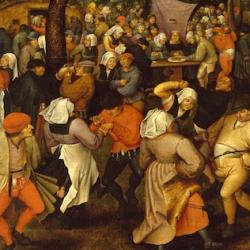When teaching hermeneutics, I’ve limited myself to giving students two rules: “Pay attention!” and “Remember!” The exclamation points are essential.
Professional readers don’t always observe these rules. For instance: Satan is mentioned twice in Revelation 2-3 in connection with synagogues: Jewish communities that oppose the gospel and accuse Christians are denounced as “synagogues of Satan” (Revelation 2:9; 3:9). “Devil” is first used in Revelation in the same context: He is about to put some of the Christians of Smyrna into prison (2:10). It seems that the “synagogues of Satan” are connected with the “devil’s” efforts to imprison Christians.
When Satan reappears in chapter 12, identified as the ancient serpent and the devil, you’d think commentators would remember chapters 2-3. Few do. They see John’s visions of Satan’s fall and the rise and progress of the beasts (Revelation 12-13) as an allegory of Roman persecution, which is correct. But few even consider the possibility that the persecution has something to do with non-Christian Jews. There’s a false prophet helping the Satanically-inspired sea beast. Is it possible that he’s a symbol for some sector of Judaism? Few think to ask.
Reach further back, remember further back. Satan is mentioned once in John’s Gospel, when he enters Judas the betrayer. Jesus speaks of the devil in John 8, telling the Jews who believed in Him and then abandoned Him that they are children of their father the devil (John 8:44). Those apostates are betrayers like Judas.
Even those who doubt that the same John wrote the Gospel and Revelation recognize common themes and terms in the Johannine corpus. You’d think that John 8 might play a role in understanding Revelation 12-13 would remember the passage. You’d think that commentators might ponder whether the beasts are or are connected to groups that, like the Jews in John, once followed Jesus and then abandoned Him. You’d be mostly wrong.
At the climax of John’s account of Jesus’ trial scene, Pilates asks the Jewish leaders clamoring for Jesus’ death, “Shall I crucify your king?” They answer, “We have no king but Caesar” (John 19:15; only in John’s Gospel). You’d think this would be relevant to sorting out the visions of the beasts in Revelation 13. You’d be mostly wrong again.
Forgetfulness is one problem. Deliberate forgetfulness is another. The obvious reason why few bring up the “synagogue of Satan” when talking about the beasts, the reason why nearly everyone forgets about John 8 when interpreting Revelation, the reason why few consider the possibility that Jews are allied with the Caesar beast is the fear of being branded antisemitic. This is programmed forgetfulness.
There is nothing antisemitic about reading these texts together. It is historical fact that some Jews, especially among the temple and intellectual elites, wanted to kill Jesus. It’s a fact that these same Jewish elites tried to suppress the apostles and killed Stephen, the first Christian martyr. It’s a fact that some Jewish Christians felt pressure to abandon Jesus and return to old forms of Judaism, and a fact that the church regarded them as defectors and traitors.
Besides, the apostles and Stephen were of course themselves Jews; the Jesus movement was a sword cutting Judaism into pieces (or, more accurately, delivering another cut to an already divided Judaism). You may not believe any Jews would say “We have no king but Caesar,” but the first Christians believed they said it, and it’s relevant to understanding Revelation. We might wince when Jesus condemns Jews who abandon Him as children of the devil, but John tells us that He said it.
Responsible interpretation depends on memory, and it requires us to overcome inadvertent forgetfulness and to resist programmed forgetfulness.









